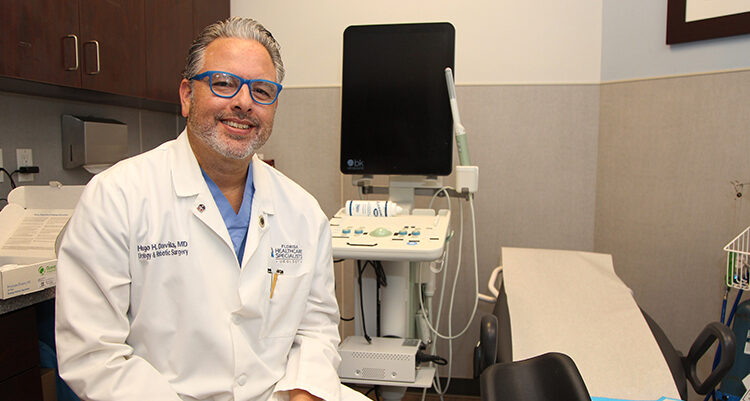According to Harvard Medical School, “by the age 60, half of all men will have an enlarged prostate, a condition also known as ‘benign prostatic hyperplasia’ or BPH. By age 85, that proportion reaches 90 percent.”
That’s the bad news.
The good news, according to Dr. Hugo Davila, one of Vero Beach’s top urologists as well as a robotic and pelvic reconstruction surgery specialist, is there are multiple options for treating BPH, including two new procedures called “Rezum” and “UroLift” that are delivering excellent results.
“The first step that we always do,” says Davila, who is with Florida Healthcare Specialists, “is try what we call behavioral changes.
“What that means is we look into your diet and then if you tell me, ‘Hey, Dr. Davila, I love to drink coffee. I like tea. I drink Coke,’ I may say, ‘Well, we need to stop that because maybe the frequency, the urgency, the waking up at night is due to that. About 30 to 35 percent of the time we’ll fix the problem just by looking to the diet.”
Before going on to discuss other treatments, Davila is quick to quash one major misconception about the condition: BPH is not a symptom or precursor of prostate cancer. In fact, it doesn’t even marginally raise your risk of getting prostate cancer.
If diet and behavioral changes don’t stop the patient’s symptoms – frequent or urgent need to urinate, the increased frequency of urination (particularly at night), the difficulty in starting a urine stream or having a weak stream or one that involuntarily stops and starts, and a general inability to completely empty the bladder – the next most likely step is medication.
“These medications help open up the prostate and allow you to empty better,” Davila says. “One that we have been using for many, many years is what we call Tamsulosin or Flomax.”
While Flomax works well to treat BPH symptoms, Davila notes there can be two side effects that rankle some men.
One, he says, “is retrograde ejaculation,” meaning that when the man has an orgasm and an ejaculation, rather than going forward, it will go backward into the bladder.
Possibly understating the obvious, he adds, “Patients don’t like that.”
The other side effect, according to Davila, is dizziness. “In about 10 to 15 percent of patients taking Tamsulosin, their blood pressure can decrease, and they can become dizzy. That’s the reason we ask them to take it before they go to sleep.”
If medicine doesn’t solve the problem, Davila might suggest the “Rezum” or “UroLift” procedures.
“The whole idea,” Davila continues, is if lifestyle changes and medications don’t solve the problem, “the next steps are these two procedures, depending on how big your prostate is. If your prostate is less than 80 grams, then you can be a candidate for either the Rezum or the UroLift.”
The goal of these two new techniques is to eliminate the blockage caused by the prostate, open the urinary pathway and allow improved urinary flow – all in a less invasive way than was previously available.
The Rezum procedure uses sterile water vapor (steam) that is injected at nine-second intervals into the enlarged portions of the prostate. The steam causes the prostate cells that are responsible for the enlargement to die, which then leads to shrinking of the prostate, which in turn creates a more open urinary pathway. It does require mild sedation (like sedation used for a colonoscopy) but the treatment time is only 10 to 15 minutes.
The UroLift System uses a decidedly different approach for treating BPH. It lifts and holds the enlarged prostate, so it no longer blocks the urethra. It is the only BPH treatment performed by a urologist that does not require heating, cutting or removal of the prostate tissue.
The procedure is typically performed using local anesthesia in a physician’s office or ambulatory surgery center. Patients typically return home the same day without a catheter. Titanium clips hold the prostate off the urethra allowing a normal flow of urine.
A June 2020 article in Urology Times claimed “patient experience was superior with the UroLift prostatic urethral lift versus the Rezum tissue ablation with steam injection according to individuals who received one of these two minimally invasive surgical therapies for BPH.”
Still, it would be wise to discuss both options with your urologist – though Davila says that patients may have to wait 25 to 45 days before the full effects of the Rezum procedure kick in while the UroLift offers almost immediate relief.
The effects of both procedures tend to last about five years.
Dr. Hugo Davila is with Florida Healthcare Specialists. He has offices in Vero Beach and Sebastian. In Vero, the address is 3730 7th Terrace, Suite 101; in Sebastian the address is 1627 U.S. 1, Suite 201. The phone number for both offices is 772-581-0528.

